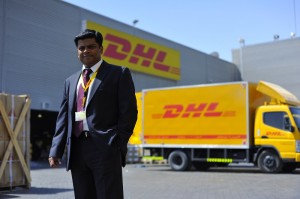Globally known logistics firm DHL is no stranger to making a fast, first-class delivery. So it was never in doubt that, when its Express division made the move to bring in virtual desktops, the project would be implemented quickly, seamlessly and successfully.
“It sounds like a cliché, but the information on the package is as important as the delivery of that package,” says Praveen Sashi, Head of IT, DHL Express, as he explains that the IT department of the world’s most successful logistics company is pivotal to how it operates.
DHL Express in the UAE had been struggling with its desktop management during a difficult time for businesses. Back in 2009, when half the world was suffering from a recession, DHL was searching for ways to improve its financial efficiency, as well as improving its service maintenance and management.
Praveen Sashi, who has headed IT at the company since that year, says that the idea of virtual desktops was like a light at the end of a tunnel.
“We had a lot of systems which were coming to the end of their time and needed upgrading or completely replacing. Also, around this time, we were searching for ways to manage our costs and reduce our servers, even application convergence and things like this. We had a lot on, and virtual desktop technology was maturing at the time, so that’s when we started looking into it,” he recalls.
Scouting the talent
With costs and timing playing a large role in the development of this project, DHL couldn’t really afford to make any ad hoc moves, so it set about a very thoroughly planned-out proof of concept (POC) in order to gain a broad view of the solutions on the market, and therefore make a highly educated decision on which vendor to choose.
“We had a very specific set of criteria that we needed to fulfil. We wanted something that integrated into our existing infrastructure easily, something that was cost-efficient, something that was user-friendly. We run a real-time customer call centre here, so we needed something that was user-friendly and engaging.”
DHL ran three separate 30-day POCs in succession and decided that the overall winner, which most closely matched the requirements needed, was VMware. Sashi believes that the choice to go with VMware made DHL one of the earliest VMware virtual desktop adopters, back when the project began in 2010.
“They matched our requirements more closely than the other two vendors which we trialled. They began the implementation in early 2010 and within roughly three months, the majority of our office here was running virtual desktops,” Sashi says.
“We obviously wanted someone in-house with the skills to manage this, so we had one employee shadowing VMware as it implemented the solution. We supported this with the VMware certification course and now we’ve one employee who is fully certified to manage the technology.”
Sashi claims that the consolidation of workflows has improved significantly since the implementation of the virtual desktops. Provisioning a desktop from one central, virtual hub can take less than a few minutes and overall management of the entire centre is done with complete ease.
Safety first
Of course, transferring all desktop applications and managing data access in a roaming environment can raise the alarm bells when it comes to security. However, Sashi says that managing security has improved, too.
“Now we’ve nothing being stored locally, people are accessing everything from one central location and in that regard, it’s easier to implement better controls on the server. The security is hugely improved in that way.”
Moreover, the overall administration has become easier for Sashi’s team, not to mention disaster recovery.
“If the facility went down, you wouldn’t be able to run a call centre. Now, if the facility goes down, we can just walk over to our alternative location across the road and download all of our desktop applications and data and we’re back on again. Then the employees can access anything they need to again, from wherever they may be.”
Some main improvements which stand out for Sashi are, firstly, the fact that the server management has been so brilliantly improved means that administrative staff have been able to free up far more time to do other tasks and learn new skills.
“Customer service and business growth are a focus point for us now, and since we no longer need to concentrate on running and maintaining servers, we can put far more time into these two areas,” he explains.
Secondly, the more obvious of the two, is the cost saving.
“We had a lot of servers and desktops becoming redundant, and would have to upgrade software around every third year. Now, with the virtual desktop, we’ve increased that time scale to seven years.”
Standing strong
Since the implementation, Sashi says that DHL hasn’t needed to have too much communication with VMware; the stability of the project ensured that DHL would be able to manage and control the technology in-house.
“We only really call on VMware if we wish to discuss ways of improving the product or the set-up; we don’t ever need to call them with a problem or a technical issue. The model we put in was so robust and the effort it takes to maintain it now is so much less than before that we’re absolutely fine by ourselves.”
The importance of this project cannot be understated – this is the first trial implementation for this technology and now Sashi and his team are being used as the example for the next wave of implementations elsewhere in the world.
“We were the first to trial this, we’ve had a very successful time with it and now we’re pushing it forward for consideration by the rest of our company. As well as this, we still have plenty of other big projects lined up for the foreseeable future, our priority being projects that aim to improve internal efficiencies, deliver great service quality to our customers, and support business growth.”
DHL Express is currently trialling the use of public cloud in order to deliver logistics and warehousing solutions in this region. The subscription-based model aims to utilise the benefits of cloud technology to deliver application services that add new business capabilities, improve operations, and overall provide better services.






